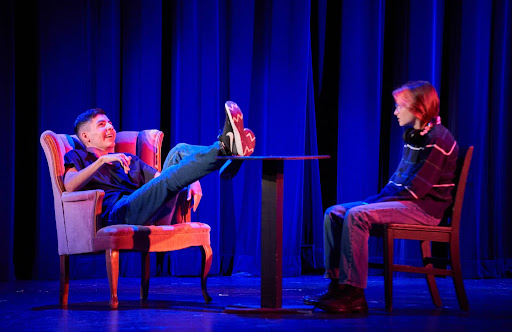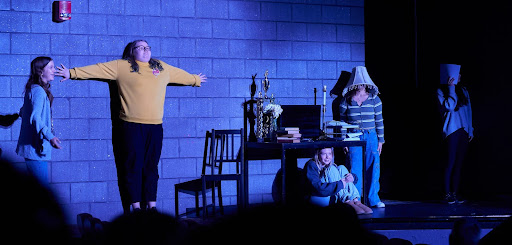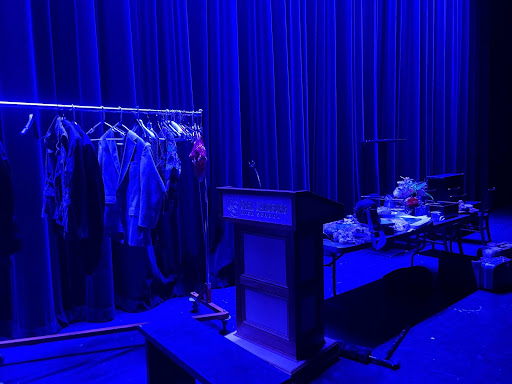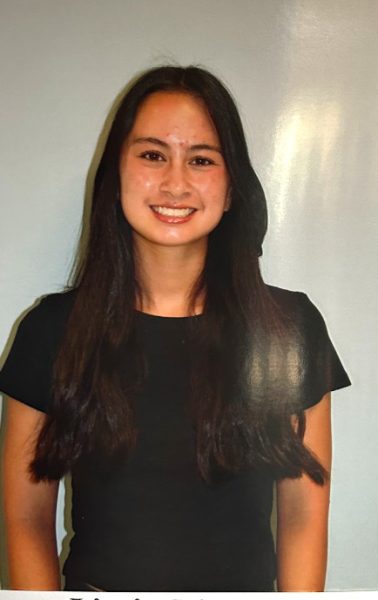The music stops, the lights dim, voices settle, and there’s a rushed rustle as everything fades to black. A voice fills the theater, reminders of no flash photography and an introduction to the show spoken through the familiar filter of the microphone. And then finally, a spotlight shines on the stage, and the 2024 Winter One Acts begin.
Friday, February 2 marked the first performances of Sandburg’s Winter One Acts: short, one-act plays written, directed, and performed by high school students. Interspersed between the stories were two mini-acts, a song, and a dance.

This year’s show included The Optimist and the Pessimist by Emilia Stepansky, Wolf Night by Jainoor Bajwa, Disorder in the Court by Kate Kanagy, The Show Must Go On by Sophia and Elena Dorantes, and The Great Golden Fork by Addison Manning, Cayla Evans, and Tamara Alnasrawi. The characters had strong personalities, and all the stories were comedic, full of jokes and funny moments. Emilia Stepansky sang “Sentó nel core” by Allesandro Scarlatti, and Gabriela Gomez choreographed a hip-hop dance to the song “Poison” by Bell Biv Devoe.
Although the PAC wasn’t totally full with people, laughter filled the empty seats time and time again. The show was put on again on Sunday, February 4, with seniors Julia Pavic, Lucy Hawksworth, and Jainoor Bajwa kissing the stage after bows.
The final performance, perhaps the most nerve-wracking of them all, was Monday, February 5, done for teachers and peers. Teachers signed up their classes so they could enjoy three of the five one-acts that were performed during their slot for periods one through seven. Second period was reserved for a necessary break, while eighth period was the designated time for set strike. The lineup was different from the first two performances, with the exclusion of the mini-acts and only 3 one-acts reserved for each period — rather than the five previously presented in total.
As all the actors were in multiple shows, it made for a tiring but rewarding day. Joanna Mathew commented, “All the actors did an amazing job portraying the roles.” Overall, the one-acts were received well, roaring applause after every scene change. The house was filled to the brim at times, and there was a constant rush of energy. Quick changes were plentiful and breaks were short.

The special thing about Winter One Acts is that Sandburg students do it all, aside from the organizing help of the teacher-sponsor, Mr. McDonough. It’s more flexible than the Spring Musical or Fall Play, and also is done in a compact amount of time, with rehearsals over the span of a month. All students who auditioned were cast as well, so it’s a very open program that has the ability to ease someone into the world of theater.
“Winter One-Acts ha[ve] given us opportunity, because we are able to have creative freedom,” remarks actor Julia Pavic. Since the one-acts are all original, they grow and change until taking their final form right around tech week (the week leading up to the show, typically with the most plentiful and longest rehearsals). One-acts are also not bound to copyright restrictions due to licensing, as most productions are. From an actor’s perspective, it’s fun and involved, with a shorter commitment than other productions.
Students also serve as the directors. “It’s a cool experience to see how they take on that role of being a director, which isn’t very common for kids our age,” says actor Allison Belair.
And it isn’t common. The ability, resources, and opportunity to direct all seem to come with getting older, into adulthood, for those who do it professionally as a job. It’s a lot to handle. But under the guidance of Mr. McDonough, students get the chance to direct their own pieces to get an understanding of what it’s like and how to do it.
Winter One Acts create a space that fosters creativity and gives students an opportunity for leadership, to learn how all the pieces of a show interact. “It really challenged me in a lot of ways to learn how to be more assertive for myself and direct a group of people,” says Sophia Dorantes, director of The Show Must Go On.
But ultimately, directing is a challenge that these students faced head-on. Another director, Emilia Stepansky notes that, “One of the hardest parts is just getting started.”
There’s a large community and a lot of people to help along the way in theater. Sometimes, however, these people are hidden: their all-black getups conceal them during blackouts (periods when it’s completely dark, usually for a scene change). These people would be those in the stage crew. Getting a show stage-ready is only half the battle; the rest of it comes from keeping it all working on the stage.
How did all those props get up there? Stage crew. Who’s controlling that spotlight? Stage crew. They pull back the curtain, and they are the reason why it’s ready to be pulled. They handle all of the moving parts within Winter One Acts, constantly at the ready in the wings.

“It’s definitely challenging,” says Addison Manning, who worked in the light booth. “It’s hard work because you’re kind of in charge of a lot of things at once, but it’s very worth it in the end.” And in the end, two successful shows were run, and the school day performances went off without a hitch.
As it was from the beginning, the end of Winter One Acts was met with a team effort, with everyone helping to strike the set and clean up the PAC at the end of Monday. The buzz from the day slowly died down, swept away like the pine needles from the tree in The Great Golden Fork. Everyone got their own copy of this year’s poster, taken from the wall where people had been signing them. The series of student-led performances that had started on Friday ended that Monday, but the memories made would live on.



